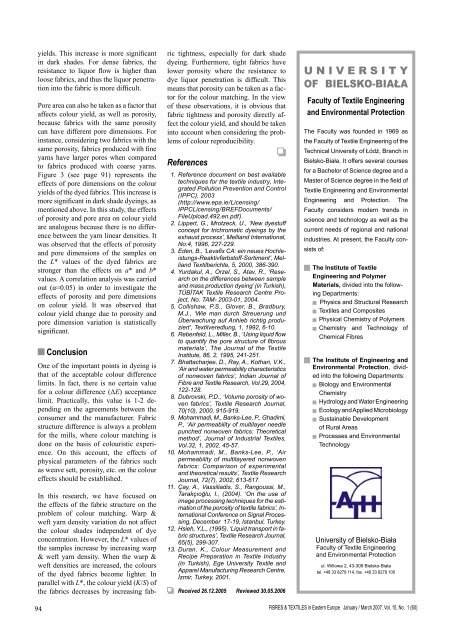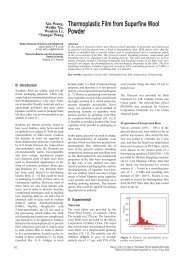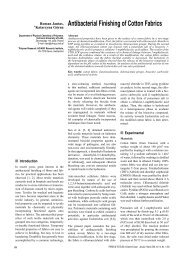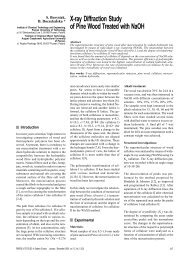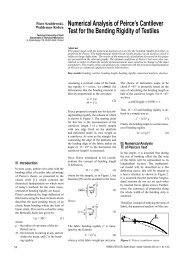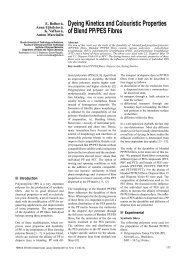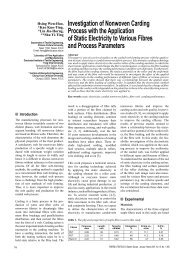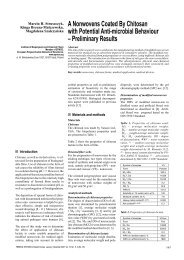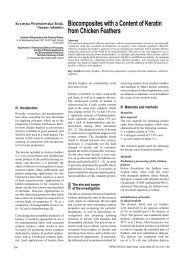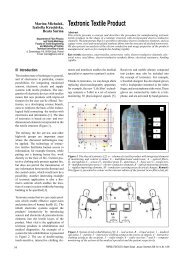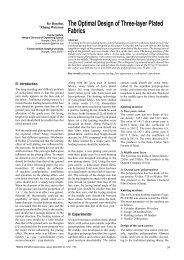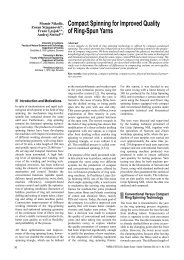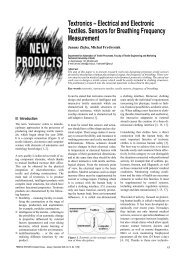Effects of Warp-Weft Density Variation and Fabric - Fibres & Textiles ...
Effects of Warp-Weft Density Variation and Fabric - Fibres & Textiles ...
Effects of Warp-Weft Density Variation and Fabric - Fibres & Textiles ...
You also want an ePaper? Increase the reach of your titles
YUMPU automatically turns print PDFs into web optimized ePapers that Google loves.
yields. This increase is more significant<br />
in dark shades. For dense fabrics, the<br />
resistance to liquor flow is higher than<br />
loose fabrics, <strong>and</strong> thus the liquor penetration<br />
into the fabric is more difficult.<br />
Pore area can also be taken as a factor that<br />
affects colour yield, as well as porosity,<br />
because fabrics with the same porosity<br />
can have different pore dimensions. For<br />
instance, considering two fabrics with the<br />
same porosity, fabrics produced with fine<br />
yarns have larger pores when compared<br />
to fabrics produced with coarse yarns.<br />
Figure 3 (see page 91) represents the<br />
effects <strong>of</strong> pore dimensions on the colour<br />
yields <strong>of</strong> the dyed fabrics. This increase is<br />
more significant in dark shade dyeings, as<br />
mentioned above. In this study, the effects<br />
<strong>of</strong> porosity <strong>and</strong> pore area on colour yield<br />
are analogous because there is no difference<br />
between the yarn linear densities. It<br />
was observed that the effects <strong>of</strong> porosity<br />
<strong>and</strong> pore dimensions <strong>of</strong> the samples on<br />
the L* values <strong>of</strong> the dyed fabrics are<br />
stronger than the effects on a* <strong>and</strong> b*<br />
values. A correlation analysis was carried<br />
out (α=0.05) in order to investigate the<br />
effects <strong>of</strong> porosity <strong>and</strong> pore dimensions<br />
on colour yield. It was observed that<br />
colour yield change due to porosity <strong>and</strong><br />
pore dimension variation is statistically<br />
significant.<br />
n Conclusion<br />
One <strong>of</strong> the important points in dyeing is<br />
that <strong>of</strong> the acceptable colour difference<br />
limits. In fact, there is no certain value<br />
for a colour difference (ΔE) acceptance<br />
limit. Practically, this value is 1-2 depending<br />
on the agreements between the<br />
consumer <strong>and</strong> the manufacturer. <strong>Fabric</strong><br />
structure difference is always a problem<br />
for the mills, where colour matching is<br />
done on the basis <strong>of</strong> colouristic experience.<br />
On this account, the effects <strong>of</strong><br />
physical parameters <strong>of</strong> the fabrics such<br />
as weave sett, porosity, etc. on the colour<br />
effects should be established.<br />
In this research, we have focused on<br />
the effects <strong>of</strong> the fabric structure on the<br />
problem <strong>of</strong> colour matching. <strong>Warp</strong> &<br />
weft yarn density variation do not affect<br />
the colour shades independent <strong>of</strong> dye<br />
concentration. However, the L* values <strong>of</strong><br />
the samples increase by increasing warp<br />
& weft yarn density. When the warp &<br />
weft densities are increased, the colours<br />
<strong>of</strong> the dyed fabrics become lighter. In<br />
parallel with L*, the colour yield (K/S) <strong>of</strong><br />
the fabrics decreases by increasing fab-<br />
94<br />
ric tightness, especially for dark shade<br />
dyeing. Furthermore, tight fabrics have<br />
lower porosity where the resistance to<br />
dye liquor penetration is difficult. This<br />
means that porosity can be taken as a factor<br />
for the colour matching. In the view<br />
<strong>of</strong> these observations, it is obvious that<br />
fabric tightness <strong>and</strong> porosity directly affect<br />
the colour yield, <strong>and</strong> should be taken<br />
into account when considering the problems<br />
<strong>of</strong> colour reproducibility.<br />
References<br />
1. Reference document on best available<br />
techniques for the textile industry, Integrated<br />
Pollution Prevention <strong>and</strong> Control<br />
(IPPC), 2003<br />
(http://www.epa.ie/Licensing/<br />
IPPCLicensing/BREFDocuments/<br />
FileUpload.492.en.pdf).<br />
2. Lippert, G., Mrotzeck, U., ‘New dyestuff<br />
concept for trichromatic dyeings by the<br />
exhaust process’, Melli<strong>and</strong> International,<br />
No:4, 1996, 227-229.<br />
3. Eden, B., ‘Levafix CA: ein neues Hochleistungs-Reaktivfarbst<strong>of</strong>f-Sortiment’,Melli<strong>and</strong><br />
Textilberichte, 5, 2000, 386-390.<br />
4. Yurdakul, A., Orzel, S., Atav, R., ‘Research<br />
on the differences between sample<br />
<strong>and</strong> mass production dyeing’ (in Turkish),<br />
TÜBİTAK Textile Research Centre Project,<br />
No. TAM- 2003-01, 2004.<br />
5. Collishaw, P.S., Glover, B., Bradbury,<br />
M.J., ‘Wie man durch Streuerung und<br />
Überwachung auf Anhieb richtig produziert’,<br />
Textilveredlung, 1, 1992, 6-10.<br />
6. Rebenfeld, L., Miller, B., ‘Using liquid flow<br />
to quantify the pore structure <strong>of</strong> fibrous<br />
materials’, The Journal <strong>of</strong> the Textile<br />
Institute, 86, 2, 1995, 241-251.<br />
7. Bhattacharjee, D., Ray, A., Kothari, V.K.,<br />
‘Air <strong>and</strong> water permeability characteristics<br />
<strong>of</strong> nonwoven fabrics’, Indian Journal <strong>of</strong><br />
Fibre <strong>and</strong> Textile Research, Vol.29, 2004,<br />
122-128.<br />
8. Dubrovski, P.D., ‘Volume porosity <strong>of</strong> woven<br />
fabrics’, Textile Research Journal,<br />
70(10), 2000, 915-919.<br />
9. Mohammadi, M., Banks-Lee, P., Ghadimi,<br />
P., ‘Air permeability <strong>of</strong> multilayer needle<br />
punched nonwoven fabrics: Theoretical<br />
method’, Journal <strong>of</strong> Industrial <strong>Textiles</strong>,<br />
Vol.32, 1, 2002, 45-57.<br />
10. Mohammadi, M., Banks-Lee, P., ‘Air<br />
permeability <strong>of</strong> multilayered nonwoven<br />
fabrics: Comparison <strong>of</strong> experimental<br />
<strong>and</strong> theoretical results’, Textile Research<br />
Journal, 72(7), 2002, 613-617.<br />
11. Çay, A., Vassiliadis, S., Rangoussi, M.,<br />
Tarakçıoğlu, I., (2004). ‘On the use <strong>of</strong><br />
image processing techniques for the estimation<br />
<strong>of</strong> the porosity <strong>of</strong> textile fabrics’, International<br />
Conference on Signal Processing,<br />
December 17-19, Istanbul, Turkey.<br />
12. Hsieh, Y.L., (1995). ‘Liquid transport in fabric<br />
structures’, Textile Research Journal,<br />
65(5), 299-307.<br />
13. Duran, K., Colour Measurement <strong>and</strong><br />
Recipe Preparation in Textile Industry<br />
(in Turkish), Ege University Textile <strong>and</strong><br />
Apparel Manufacturing Research Centre,<br />
İzmir, Turkey, 2001.<br />
Received 26.12.2005 Reviewed 30.05.2006<br />
U N I V E R S I T Y<br />
OF BIELSKO-BIAŁA<br />
Faculty <strong>of</strong> Textile Engineering<br />
<strong>and</strong> Environmental Protection<br />
The Faculty was founded in 1969 as<br />
the Faculty <strong>of</strong> Textile Engineering <strong>of</strong> the<br />
Technical University <strong>of</strong> Łódź, Branch in<br />
Bielsko-Biała. It <strong>of</strong>fers several courses<br />
for a Bachelor <strong>of</strong> Science degree <strong>and</strong> a<br />
Master <strong>of</strong> Science degree in the field <strong>of</strong><br />
Textile Engineering <strong>and</strong> Environmental<br />
Engineering <strong>and</strong> Protection. The<br />
Faculty considers modern trends in<br />
science <strong>and</strong> technology as well as the<br />
current needs <strong>of</strong> regional <strong>and</strong> national<br />
industries. At present, the Faculty consists<br />
<strong>of</strong>:<br />
g The Institute <strong>of</strong> Textile<br />
Engineering <strong>and</strong> Polymer<br />
Materials, divided into the following<br />
Departments:<br />
g Physics <strong>and</strong> Structural Research<br />
g <strong>Textiles</strong> <strong>and</strong> Composites<br />
g Physical Chemistry <strong>of</strong> Polymers<br />
g Chemistry <strong>and</strong> Technology <strong>of</strong><br />
Chemical <strong>Fibres</strong><br />
g The Institute <strong>of</strong> Engineering <strong>and</strong><br />
Environmental Protection, divided<br />
into the following Departments:<br />
g Biology <strong>and</strong> Environmental<br />
Chemistry<br />
g Hydrology <strong>and</strong> Water Engineering<br />
g Ecology <strong>and</strong> Applied Microbiology<br />
g Sustainable Development<br />
<strong>of</strong> Rural Areas<br />
g Processes <strong>and</strong> Environmental<br />
Technology<br />
University <strong>of</strong> Bielsko-Biała<br />
Faculty <strong>of</strong> Textile Engineering<br />
<strong>and</strong> Environmental Protection<br />
ul. Willowa 2, 43-309 Bielsko-Biała<br />
tel. +48 33 8279 114, fax. +48 33 8279 100<br />
FIBRES & TEXTILES in Eastern Europe January / March 2007, Vol. 15, No. 1 (60)


